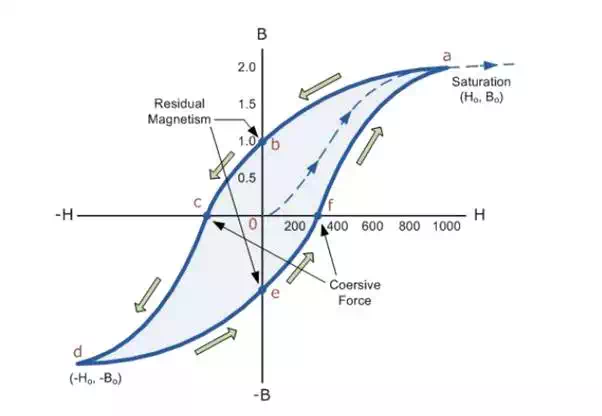Ferrimagnetism and property of ferromagnetic materials(ferrites)
Ferrimagnetic substance are those in which the atomic or ionic dipoles in one direction are of unequal magnitudes ,this alignment of dipole gives a net magnetization and is the property of those magnetic substance which have two or more different kind of atoms

In ferri magnetic materials there may be large net magnetization as compared to anti-Ferro magnetic materials, due to the resultant of anti-parallel alignment of neighboring dipoles of unequal magnitudes.
Ferrimagnetic materials generally known as ferrites consist of two or more different kind of atoms their formula is




Application of ferrites(ferromagnetic substance)
1. They are used to produce ultrasonic by magnetization principle.
2. Ferrites are used in audio and video transformers.
3. Ferrites rods are used in radio receivers to increase the sensitivity.
4. They are also used for power limiting and harmonic generation.
5. Ferrites are used in computers and data processing circuits
6. ferrites are used in switching circuits and in storage devices of computers.
7. Ferrites are not metals but their resistivity lies in the range of insulators or semiconductors.
Explanation of hysteresis curve based on domain theory of ferromagnetism:
Domain theory of ferromagnetism
According to Weiss a virgin specimen of ferromagnetic material consist of a number region or domains which are spontaneously magnetized .In each domain spontaneous magnetization is due to parallel alignment of all magnetic dipoles
The direction of spontaneous magnetization varies from domain to domain
The resultant magnetization may hence be zero or nearly zero
When an external field is applied there are two possible ways of alignment of domains
(i)By motion of domain walls: the volume of domains that are favourably oriented with the respect to the magnetizing field increases at the cost of those that are unfavourably oriented fig(b)
(ii)By rotation of domains: when the applied magnetic field is strong rotation of the direction of magnetization occurs in the direction of the field. Fig(c)

Hysteresis curves

Hysteresis : lagging of magnetization behind the magnetizing field(H)
We know when the ferro magnetic material is subjected to external field ,there is increase in the value of the resultant magnetic moment due to two process
(i)the movement of domain walls
(ii)rotation of domain walls
When a weak magnetic field is applied the domains are aligned parallel to the field and in the easy direction of magnetization grow in size at the expense of the less favourably oriented domains.
This result in the Bloch wall (or)domain wall movement and when the weak field is removed the domains reverse back to their original state .this reversible wall displacement is indicated by OA the magnetization curve.
When the field becomes stronger han the domain wall movement continues and it is mostly reversible movement .this is indicated by path AB of the graph .the phenomena of hysteresis is due to the irreversibility.
At the point B all domains have got magnetized along their easy direction
Application of still higher field rotates the domains into the field direction indicated by BC.
Once the domains rotation is complete the specimen is saturated denoted by C.
Thus the specimen is said to be attain the maximum magnetization .at this position if the external field is removed (H=0),the magnetic induction B will not fall rapidly to zero ,but falls to D rather than O this shows that even when the applied field is zero the material still possess some magnetic induction(OD)which is called residual magnetism or retentivity.
Actually after the removal of the external field the specimen will try to attain the original configuration by the movement of domain wall .But this movement is stopped due to the presence of impurities, lattice imperfections.
Therefore to overcome this a large amount of reverse magnetic field ( ) is applied to the specimen .the amount of energy spent to reduce the magnetization (B) to zero is called “coercitivity” represented by OE in the fig.